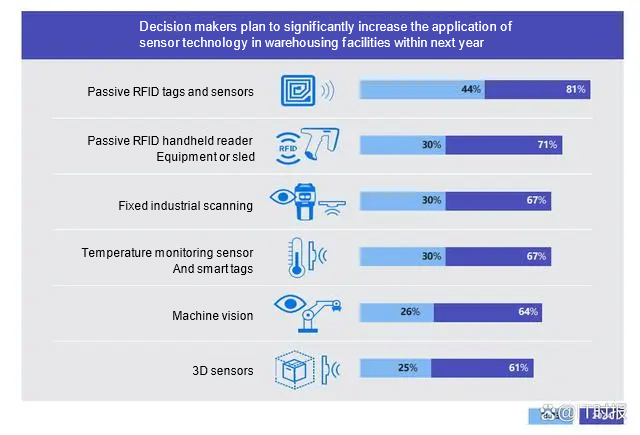2023 marks the 50th anniversary of the invention of radio frequency identification (RFID) technology, which has now become a powerful tool for front-line workers in warehouses and other industries to improve efficiency and reduce production.
On November 23, digital solutions provider Zebra Technologies released the 2023 "Global Warehousing Vision Research Report" (hereinafter referred to as the "Report"). Research results show that 58% of the surveyed warehousing industry decision-makers plan to deploy RFID technology before 2028 to improve inventory visibility and reduce out-of-stocks. In other words, within the next five years, RFID readers and fixed industrial scanning solutions will enter most warehouses to better track assets, workers and goods.
In China, especially in response to online shopping peaks such as Double 11 and June 18, most e-commerce core warehouses will deploy automation, digitization, and intelligence in order to avoid pressures such as "full warehouses" and a sharp increase in returns. Cheng Ning, technical director of Zebra Technologies Greater China, said that the automation level of China's warehousing industry leads the world, but it is highly concentrated and mainly covers core warehouses and large warehouses. In the future, intelligent applications will gradually cover edge warehouses.

Returns are the biggest challenge in the warehousing industry
According to Zebra Technologies’ 2023 Global Warehousing Vision Research Report, inventory inaccuracies and out-of-stocks remain major challenges to warehouse productivity. So what is the biggest challenge? Nearly half of decision makers surveyed (47% globally and 40% in Asia Pacific) consider returns management to be the biggest operational challenge. The best solution is modernization, digitalization and intelligence.
The report shows that 73% of the global decision makers surveyed have or will speed up modernization projects, and 69% in the Asia-Pacific region. Cheng Ning said: “The substantial increase in the volume of returns is consistent with the growth trend of e-commerce fulfillment in the past few years. This requires changes in all aspects of the supply chain, and also means that technological solutions must be used to handle returns and improve flexibility. , inventory visibility and forecast demand to increase efficiency and make better decisions in real time to modernize your business.”
For the warehousing industry, while adapting to the needs of e-commerce consumers, it is also facing pressure to improve performance. 82% of employees in the warehousing industry and 76% of decision-makers worldwide believe that they need better inventory management tools to improve accuracy and ensure that inventory counts are error-free and timely. In order to solve these problems, 91% of the decision-makers surveyed stated that they plan to increase investment in technology to improve the visibility of the overall supply chain by 2028.
 Automation improves inventory visibility
Automation improves inventory visibility
So how can we successfully improve supply chain visibility by 2028? Strengthen the capabilities of front-line employees through warehouse automation, optimize operations and improve employee morale. The report shows that more than half of decision makers surveyed plan to deploy machine learning and predictive analytics software solutions in their own facilities by 2028 (52% globally and 57% in Asia Pacific) and predictive analytics software solutions (59% globally and 63% in Asia Pacific) %).
A recent study by Interact Analysis shows that although demand for automation projects has slowed recently, in part due to a reduction in warehouse construction, this demand is expected to return to growth in 2024.
Zebra Technologies’ report also found that about 70% of the decision-makers surveyed have already or plan to automate workflows by 2024 to support warehouse employees and shift them to more customer-centric, high-value tasks. Nearly half of decision makers believe automation can reduce the workload of manual picking, reduce order errors and shorten cycle times, thereby improving employee efficiency and productivity. At the same time, about 80% of warehouse employees surveyed believe that using more technologies such as automation can help them achieve or even exceed their productivity goals.

Additionally, technology and automation improve employee morale while increasing productivity. Eighty percent of warehouse workers surveyed believe technology tools and automation make them feel more valuable. Likewise, more than 80% of surveyed decision-makers agreed that greater implementation of warehouse technology, including robots and equipment, would help attract and retain employees, which is particularly important amid labor shortages.
Sustainable operation becomes an important basis for decision-making
On what basis do decision makers choose solutions? Whether these solutions can help them build sustainable operations will be driven primarily by regulations, energy costs or shortages, and the expectations of customers, workers and investors. For example, 77% of global decision-makers surveyed focus on reducing emissions and waste, and 84% of surveyed decision-makers recognize the importance of maximizing battery life through warehousing technology solutions. These views have also been echoed in the Asia-Pacific region, with 74% and 78% of decision-makers in the Asia-Pacific region respectively agreeing with the above two aspects.
Other elements of sustainability that are being prioritized by policymakers today include ensuring accurate replacement times for mobile devices, connecting energy monitoring software to maximize efficiency, offering buy-back and certified refurbishment or circular economy programs, and using reusable and Recyclable materials. In addition to their own operations, 81% of global decision makers surveyed said it is also very important for technology suppliers to adopt sustainable development measures in their business operations.
Ultimately, warehouse operations must continue to implement agility strategies to avoid inefficiencies, protect resources and provide performance advantages to employees.

